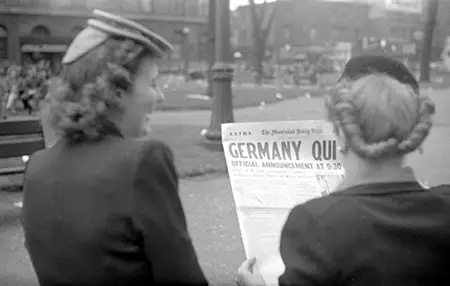End of World War 2
Because there were three main Axis powers, there were three different endings to World War II. Italy, Germany and Japan all entered the war with different goals, so they ended the war at different times.


Italy. Benito Mussolini led Italy into World War II in 1939. Italian forces fought in Greece and Northern Africa. But by 1943, Mussolini had stretched his resources as far as they would go. When the United forces of Britain, France and America attacked Sicily, they were victorious. Mussolini surrendered to the Allied forces. The European Allied Command handed the government of Italy to King Victor Emmanuel. The king then fired Mussolini from his position as Prime Minister. But that wasn’t the end of the story. When Adolf Hitler heard about the surrender, he was furious.
He sent German troops to Italy and conquered the country, putting Mussolini back in power. Germany gave the Italian the choice of fighting with the Nazis or becoming prisoners of war. Only 90,000 soldiers fought with Germany. More than 700,000 soldiers refused. The end of the war in Italy came just before the end of April in 1945. Allied Forces captured Rome. The people of Italy celebrated their liberation. Benito Mussolini and his wife tried to escape the country. They headed for Switzerland, a neutral country. But the Italian resistance caught up with them and took them captive. Benito Mussolini died April 28, 1945.

Germany. When Adolf Hitler saw that Mussolini lost power, he knew that the end was near. The Allied forces bombed Hamburg. With the city destroyed, Germany lost its western port. Allied forces pushed toward Berlin from the west. They freed prisoners in concentrations camps as they went. Allied forces took pictures of the atrocities, the horrible conditions and the dead. While there had been rumors of concentration camps, these pictures gave the first proof. Meanwhile, Stalin’s forces had defeated the German forces in the East.
Stalin freed Leningrad and pushed his troops toward Germany. In the last days of April 1945, Adolf Hitler decided he did not want the Allied troops to take him prisoner. He did not want to stand trial for the millions of people he killed. He didn’t want to be humiliated by surrendering. He didn’t want to see his Third Reich fall to the Allies. So Hitler married his fiancé, Eva Braun and both died on April 30, 1945. Over the next week, generals in many different areas from Albania to Zanzibar surrendered to Allied forces. The final cease-fire occurred on May 8, 1945. People called it “Victory in Europe” day or V-E Day.

Japan. The war in the Pacific still raged, even as Europe began to rebuild. The Allied forces liberated all the islands Japan had taken. They had bases on Okinawa and Midway, which were perfect places to launch air attacks on Japan. China and the United States cut off shipping lanes. This meant that Japan had no access to food or supplies. The shallower waters near the islands had mines, making even fishing dangerous. But Japan refused to surrender. Allied forces began bombing Japanese cities, hoping that this destruction would force Japan to surrender.
It did not. U.S. military experts discussed a land assault, but knew that would be difficult. The shape of Japan made traditional warfare difficult, if not impossible. They could continue to bomb the country, but hundreds of thousands of people may die. Instead, they told Japanese command that they had a new kind of bomb. They dropped leaflets, telling the people to leave the area. On August 6, 1945, the Enola Gay dropped the first atomic bomb on the city of Hiroshima. This single bomb destroyed the city. But still Japan did not surrender. On August 9, 1945, Allied forces dropped a second bomb on Nagasaki. The next day, August 10, 1945, Japan surrendered to Allied Forces. This ended the Second World War.



